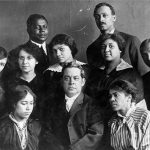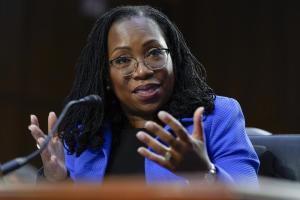Principal A.H. Parker surrounded by his Industrial High School students. The school, founded in 1900, was renamed in 1939 to A.H. Parker High School. (Birmingham, Ala., Public Library Archives.)
” data-medium-file=”https://www.birminghamtimes.com/wp-content/uploads/2025/02/Parker_Staff-300×190.jpg” data-large-file=”https://www.birminghamtimes.com/wp-content/uploads/2025/02/Parker_Staff-1024×649.jpg” tabindex=”0″ role=”button” />
By Barnett Wright | The Birmingham Times
(A closer look at Arthur Harold Parker and the school named in his honor, which celebrates 125 this year in Birmingham’s historic Smithfield community.)
Arthur Harold Parker was born on May 7, 1870, in Springfield, Ohio to former slaves of white, Black, and Chickasaw Indian descent. Arthur was one of five children.
Under slavery many states prohibited slaves from learning to read and write, so like other freed slaves, Parker’s parents stressed the importance of education to their children.
During high school, Parker’s mother fell ill from childbirth. He worked in his father’s barber shop, while continuing to attend high school classes. He also studied law for two summers under the tutelage of one of his barbering clients.
” data-medium-file=”https://www.birminghamtimes.com/wp-content/uploads/2025/02/Parker-Young-187×300.jpg” data-large-file=”https://www.birminghamtimes.com/wp-content/uploads/2025/02/Parker-Young-639×1024.jpg” tabindex=”0″ role=”button” class=”size-medium wp-image-126410″ src=”https://www.birminghamtimes.com/wp-content/uploads/2025/02/Parker-Young-187×300.jpg” alt=”” width=”187″ height=”300″ srcset=”https://www.birminghamtimes.com/wp-content/uploads/2025/02/Parker-Young-187×300.jpg 187w, https://www.birminghamtimes.com/wp-content/uploads/2025/02/Parker-Young-639×1024.jpg 639w, https://www.birminghamtimes.com/wp-content/uploads/2025/02/Parker-Young-768×1230.jpg 768w, https://www.birminghamtimes.com/wp-content/uploads/2025/02/Parker-Young-959×1536.jpg 959w, https://www.birminghamtimes.com/wp-content/uploads/2025/02/Parker-Young-262×420.jpg 262w, https://www.birminghamtimes.com/wp-content/uploads/2025/02/Parker-Young-640×1025.jpg 640w, https://www.birminghamtimes.com/wp-content/uploads/2025/02/Parker-Young-681×1091.jpg 681w, https://www.birminghamtimes.com/wp-content/uploads/2025/02/Parker-Young.jpg 1200w” sizes=”(max-width: 187px) 100vw, 187px” />
After graduating from high school with the honor of being chosen as the graduation speaker, Parker planned to attend Oberlin College. An injury suffered by his father, however, ended this dream. Instead, he packed up his barbering tools and went “prospecting” in the South.
Arrival In Birmingham
Parker arrived in Birmingham, Alabama on Aug. 17, 1887, where two of his uncles lived, Arthur Sensabaugh, a Methodist pastor, and James Clayton, a schoolteacher. Parker’s Uncle Clayton recognized Parker’s teaching talents and encouraged him to take the teacher’s examination. After successfully passing the exam, Parker was offered a teaching position and became the 13th African American teacher in the Birmingham school system.
Parker was assigned to the second graders of the new Slater School which opened in January 1888. He advanced to the third and fourth graders the next fall. As a sign of things to come, the Slater School had recently purchased an organ, so Parker spent his spare time there learning to play. He became such an accomplished organist he would play for school programs, as well as side jobs, and teach music classes. He also began working as private secretary for William Pettiford, pastor of the 16th Street Baptist Church.
During the summer of 1889, Parker returned home to Ohio to visit family. Before returning to Birmingham—and at the insistence of his mother—became engaged to and married his high school sweetheart, Mary Anderson.
Parker’s mother passed away in November 1890, and Mary died in July 1891. In the wake of his loss, he became determined to pass the principals examination. He did so in September 1892 and was transferred to the Cameron Elementary School. In addition to heading that growing school, Parker was superintendent of the Sunday school at 16th Street Baptist Church.
On June 5, 1895, Parker married Bessie D. Pettiford. She died of childbirth complications in 1896. Despondent over his loss, he stopped teaching and took a position with the Internal Revenue Service.
In 1898, Parker met and married Anna B. Gilbert, who encouraged him to return to teaching. He did so as the 7th grade teacher and assistant principal at Lane School in the fall of 1899.
In 1899, the Birmingham Board of Education agreed to create a high school for African American students. Superintendent Dr. John Herbert Phillips selected Parker to become the sole teacher for the Industrial High School when it opened, on the second floor of the Cameron School, in September 1900.
Birth of a School
In September 1900, Industrial High School—dedicated to Black students—opened on the second floor of the Cameron School. The number of students rose from 18 to 45 by the end of the school year. Parker emphasized practical instruction in woodworking, sewing, cooking, laundry work, mortis, hand carving, and drawing. His students also learned grammar, literature, and mathematics. He presided over the school’s first graduation ceremony, held June 3, 1904 at 16th Street Baptist Church.
In 1905, Parker was elected president of the Alabama State Teacher’s Association. He delivered an address to the assembled body at their next annual meeting in Mobile in April 1906. He also completed construction of a new home, which he helped finance by working as the head of the book-keeping department in the Alabama Penny Savings Bank between 1900 and 1912.
In September 1910, Industrial High moved to the Lane’s Auditorium building at 11th Street and 8th Avenue North. Specialized instructors were added to the faculty to teach cooking, sewing, and manual training. The next year a night school for adults started, and then a summer school for teachers. Parker also participated in the first of a series of state-wide summer institutes for teachers in each county.
” data-medium-file=”https://www.birminghamtimes.com/wp-content/uploads/2025/02/Parker-222×300.jpg” data-large-file=”https://www.birminghamtimes.com/wp-content/uploads/2025/02/Parker-759×1024.jpg” tabindex=”0″ role=”button” class=”size-medium wp-image-126411″ src=”https://www.birminghamtimes.com/wp-content/uploads/2025/02/Parker-222×300.jpg” alt=”” width=”222″ height=”300″ srcset=”https://www.birminghamtimes.com/wp-content/uploads/2025/02/Parker-222×300.jpg 222w, https://www.birminghamtimes.com/wp-content/uploads/2025/02/Parker-759×1024.jpg 759w, https://www.birminghamtimes.com/wp-content/uploads/2025/02/Parker-768×1037.jpg 768w, https://www.birminghamtimes.com/wp-content/uploads/2025/02/Parker-1138×1536.jpg 1138w, https://www.birminghamtimes.com/wp-content/uploads/2025/02/Parker-311×420.jpg 311w, https://www.birminghamtimes.com/wp-content/uploads/2025/02/Parker-640×864.jpg 640w, https://www.birminghamtimes.com/wp-content/uploads/2025/02/Parker-681×919.jpg 681w, https://www.birminghamtimes.com/wp-content/uploads/2025/02/Parker.jpg 1200w” sizes=”(max-width: 222px) 100vw, 222px” />
In 1914, the school building was condemned by the city and a deal was struck to purchase the former United Presbyterian School at 8th Avenue and 9th Street North. Soon after a cluster of 14 cottages on an adjacent lot was purchased and converted for classroom use.
In 1915, Parker began teaching summer classes at the Tuskegee Institute. “Education is life and I can conceive of no finer thing than doing efficiently one’s daily work,” he said.
Influenza Epidemic
In 1918, Industrial High School began setting up and printing a student newspaper. Days later, the school was temporarily closed and converted to a hospital to tend to victims of an influenza epidemic. Students served as nurses.
In 1924, at 8th Avenue North and 3rd Street, a brand new Industrial High School building opened. This well-equipped, modern facility was considered the result of Birmingham’s progressive stance on race.
Parker was also awarded the Negro Citizens’ Loving Cup for “that citizen who had done the most for his race in 1924.”
In 1933 Miles College conferred upon Parker an honorary degree, the Doctor of Letters.
The Industrial High School Printing Department published A Dream That Came True: Autobiography of Arthur Harold Parker during the 1932-1933 school year.
Parker retired as principal of Industrial High School in 1939. In his honor, the school was renamed A. H. Parker High School.
Parker died on August 17, 1939. Funeral services were held in the Parker High School Auditorium. He was interred in historic Oak Hill Cemetery where a number of other notable Birmingham citizens are buried











